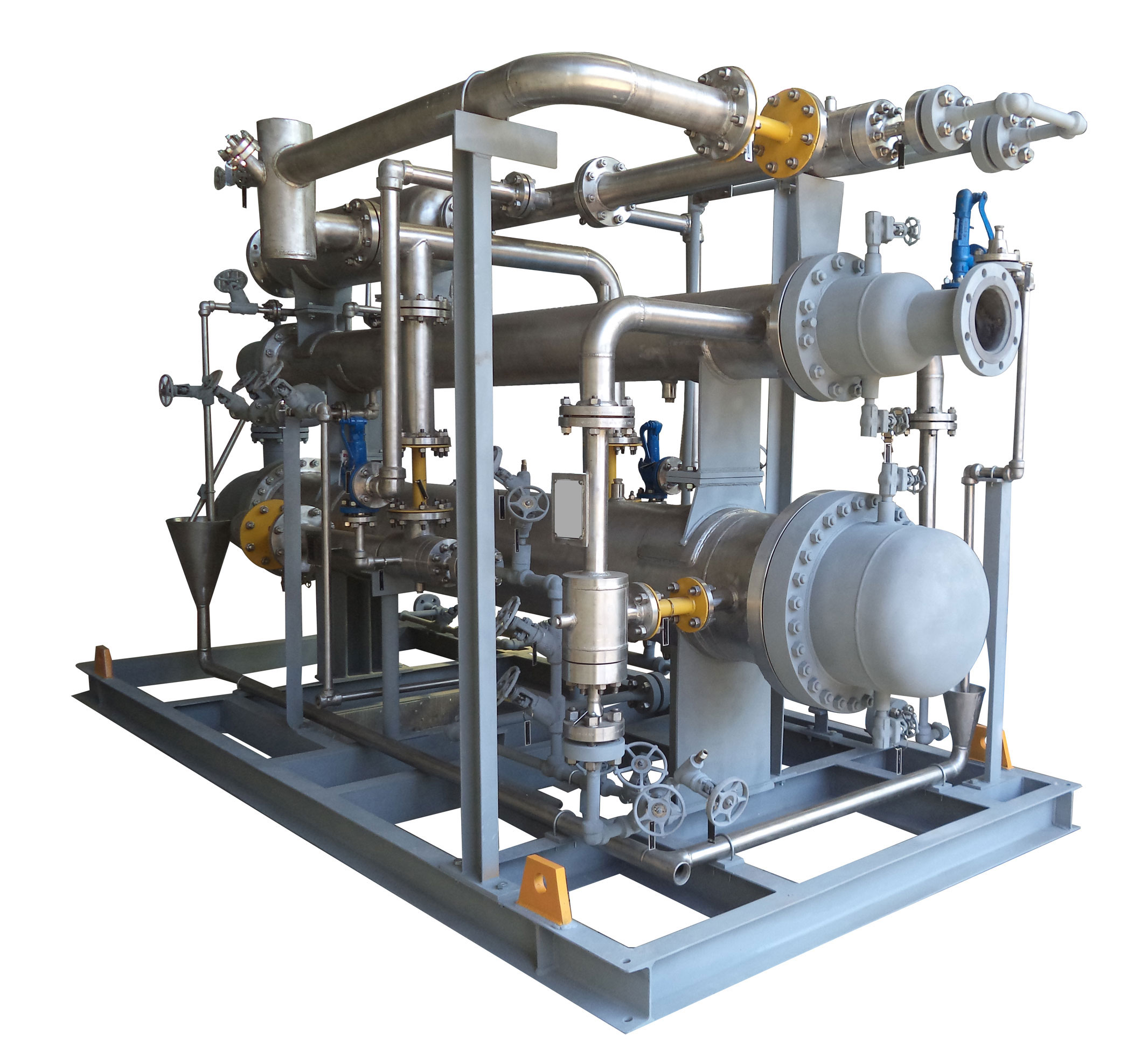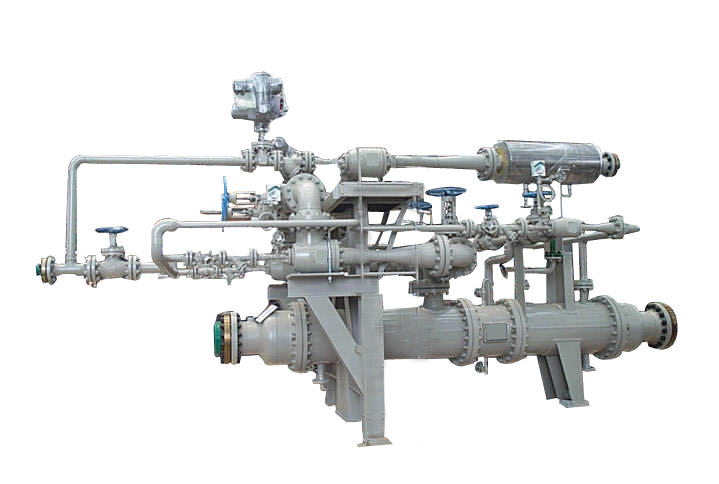
At Ejector – Vacuum technology, we are committed to supplying vacuum systems that provide our customers with the opportunity to grow their business profitably. In addition to ASME (U, S, NB, R) we regularly compliance with PED, CRN, CCOE, GOST, DOSH, IBR, AS1210. Our customer management oriented to customer value system effectively produces and delivers products to satisfy customer needs. Moreover, AAHANA Giffard system is enhancing its company capability in the overseas market as a hub of the industry by diversifying its sales and building partnerships with leading global companies such as Siemens, G.E, Mitsubishi, Doosan, Skoda Power, Alstom Power, Hyundai, Sulzer, Foster Wheeler, Flour, Toshiba, MAN, Metka, ThyssenKrupp, Enexio, Valmet, etc. Our five stage and six stage Ejectors are designed for absolute pressure range in micron range as per customers requirement. AAHANA Giffard systems has supplied Ejector systems up to a vacuum of 0.05 mm. Hg. Abs (5 stage) at full load.


EJECTORS: It uses water as the motive force. The induced fluid is entrained and condensible are condensed. The non-condensible gases are then compressed in the diffuser and discharged into a constant level water sea tank against atmospheric pressure. Maximum absolute pressure obtained by these types mainly depends on the temperature of the water or motivating fluid. These units with water at 30 C can attain an absolute pressure of 32 – 40 mm Hg at shut off and with chilled water at 3 C as motivating fluid it can attain 5 – 10 mm Hg. Generally, absolute pressure at shutoff nearly equals the vapor pressure of the operating liquid at operating temp. These units are most economical where condensible vapors are to be handled.

Steam jet ejectors are the simplest device for any vacuum operating equipment; it consists essentially of a nozzle that discharges a high-velocity jet across a suction chamber that is connected to the equipment to be evacuated. The main advantages of using our Ejectors are:
The Ejector Division provides specialized and innovative Ejector Vacuum technologies to the Power Generation, Oil & Gas, Chemical, Petrochemical, Cement, Sugar, Edible Oil Refinery and Industrial markets worldwide. Critical systems improving the reliability and safety of operations in the industries we serve, enabling our customers to solve their most difficult problems and meet their core business or operational objectives.

The operating principle of a steam jet ejector stage is that the pressure energy in the motive steam is converted into kinetic energy in the nozzle and this higher velocity of the steam entrains the gas being pumped. The resulting mixture at the resulting velocity enters a diffuser where this velocity energy is converted to pressure energy so that the pressure of the mixture at the ejector discharge is substantially higher than the pressure in the suction chamber but lower than the pressure of the motive steam. Figure 5 shows the pressure and velocity profiles in a typical steam jet ejector. A simple stage of a steam ejector has limitations on the compression possible to achieve and its performance is only good under a certain compression ratio (discharge pressure divided by the suction pressure). If greater compression ratios are needed then is possible to arrange two or more ejectors in series, thus decreasing the compression ratio in every stage. On the other hand, the amount of gas that the ejector is able to handle is fixed for every device and depends on the physical proportions of the diffuser, then to handle different volumes is required to use more than one device in parallel, these can be single o multiple stages configurations (HEI Standards, 2000)

In the field of vacuum processing, steam jet ejectors have been most widely used. Steam jet ejectors are ideal for use on all kinds of stills, vacuum deaerators, evaporators, crystallizers, oil deodorizers, steam vacuum refrigeration, flash coolers, condensers, vacuum pan dryers, dehydrators, vacuum impregnators, freeze dryers, vacuum filters, and more recently on stream degassing of metals and vacuum melting of metals. Steam jet ejectors offer operational and economical advantages over a very large range of pumping capacities. Corrosive applications are easily handled providing a suitable material is available that can withstand the corrosive medium in question with reasonable structural strength at the temperatures to be encountered by the ejector system.
Figure 3 is a comparison of capacity and operating range for most of the common designs of steam jet ejectors handling any non-condensable gas such as air. This graph is based on each of the designs using the same amount of motive steam at 100 psi pressure. Each point on the curve represents a point of maximum efficiency, therefore, it should be borne in mind that an ejector cannot necessarily operate over the entire range of suction pressures indicated for a particular design. A reasonable range of operation for good efficiency would be from 50 percent to 115 percent of the design capacity. An ejector may operate well in excess of these figures; however, the efficiency will usually decrease at points beyond these limits.
Water temperature affects the load which may be handled by an ejector. If condensing water colder than 85 F. were used for our comparison in Figure 3, all of the curves representing the performance of ejectors that require water would be shifted to the right, indicating an increase in capacity for these designs.

If water warmer than 85 F. were used, the shift in these curves would be to the left. And if the water temperature were high enough, some of the curves would move far enough to the left to disappear from the graph entirely.
The effect of water temperature is more critical on ejectors designed for low absolute pressures. For example; in a 4-stage ejector, the increase in capacity for 65 F. water over 85 F. Water for a particular steam consumption will be greater at 1 mm. Hg. Abs. than at 4 mm. Steam pressures higher than 100 psig will permit designing for a larger capacity for a particular steam consumption. A greater benefit from high steam pressures can be realized in 1- and 2-stage ejectors than in other designs.
The benefit from high-steam pressures becomes less as the absolute pressure for which the ejector is designed decreases. Single-stage ejectors designed for absolute pressures lower than 200 mm. Hg Abs. cannot operate efficiently on steam pressures below 25 psig. However, the initial stages of multistage ejectors can often be designed to operate efficiently on steam pressures below 1 psig. It is not uncommon to use an extra stage for an ejector designed to operate on steam pressures as low as 15 psig. It is very important that the steam used to motivate ejectors to be at least dry-saturated steam. Small amounts of moisture can be removed successfully by using a good, properly sized steam separator which will remove 98 to 99 percent of the moisture entering the separator.
Water jet ejectors are available that can economically handle a nominal amount of air leakage in vacuum equipment along with a large condensable vapor load. Water pressures as low as 10 to 20 psig will sustain a moderate vacuum while water pressures of 40 psig and higher will efficiently sustain a vacuum in the range of 4.0 inches to 1.0 inch Hg. Abs. pressure with a single stage ejector depending on the load to the ejector and the temperature of the motivating water.

The water operated ejector combined with a steam jet ejector can yield a very compact, efficient, and relatively inexpensive vacuum pumping system. The water jet ejector serves both as an intercondenser and a final stage to the ejector system. In instances where the non-condensables entering the ejector system are small compared to the condensable vapors, say 10 percent by weight noncondensables or less, the water jet ejector can take the place of a two stage ejector in maintaining a suction pressure of 3 inches to 2 inches Hg. Abs. to which the steam jet ejector can discharge. The result is a low priced and efficient vacuum pumping system. In Europe, an interesting equivalent to the water ejector is a centrifugal water jet ejector which combines a centrifugal pump with the ejector principle and which recirculates the motive water handling air and vapor loads in a single piece of equipment. It is likely, however, that the combination of a separate centrifugal pump and a separate water jet ejector would be a more competitive pumping system than the European centrifugal ejector pump.
In order to model the power plant's economical behavior, it is important to consider the change in the size of the equipment as the operational conditions are modified to obtain a 50 [MW] power output. For example, when the amount of non condensable gases is increased, every gas extraction system modifies its operation conditions. The steam consumption of the ejector's increase, and compressors and liquid ring vacuum pump also increase the auxiliary energy consumption. As a fixed 50 [MW] power output is required, for the energy consumption of the auxiliary system, the size of the turbine will also be modified to keep this output. When steam ejectors are used, the size of the turbine is not so drastically
affected, because the energy required to operate the ejectors comes from the steam, not from the generator itself. This is not the case of compressors or LRVP which take the power from the power plant production. It is also important to notice that the price of steam is different from the price of electricity.
To calculate the maintenance cost of the equipment a percentage of the total investment costs will be assumed, this is different for every type of equipment; in the next table the assumed values are shown: Maintenance costs per equipment

When considering ejector equipment for an application. One should include all possible information relating to the performance required by the equipment. It is important, therefore, to mention here the type of information required by the manufacturers of ejector equipment. If the manufacturer has knowledge of the application, many design considerations will be evident and so it is advantageous and sometimes very important to reveal the application when writing specifications.
4 stage steam ejector in Germany - Air ejector in Germany - Ejectors in Germany - Ejector vacuum systems in Germany - 4 stage steam ejector in UK - Air ejector in UK - Ejectors in UK - Ejector vacuum systems in UK - 4 stage steam ejector in USA - Air ejector in USA - Ejectors in USA - Ejector vacuum systems in USA - 4 stage steam ejector in Italy - Air ejector in Italy - Ejectors in Italy - Ejector vacuum systems in Itally - 4 stage steam ejector in India - Air ejector in India - Ejectors in India - Ejector vacuum systems in India. Aahana Giffard is one of the esteemed companies for manufacturing ejectors worldwide. Our ejectors are deemed of the same quality as Germany's Koerting ejectors and Wiegand ejectors, India's Mazda ejectors, USA's Graham ejectors, and UK's Transvac ejectors.